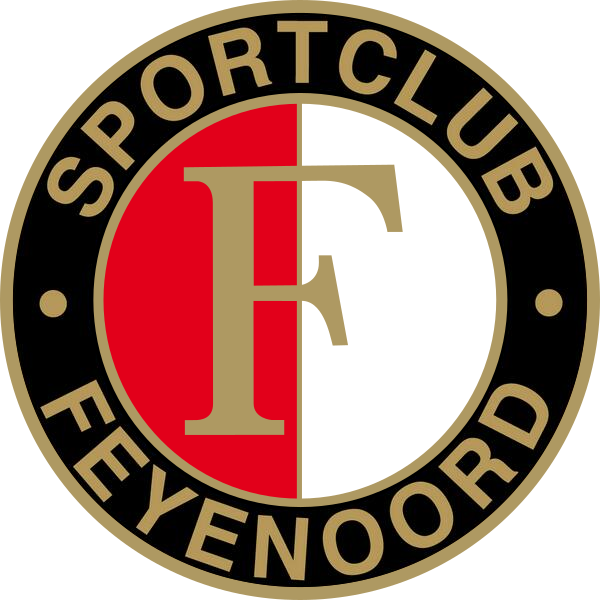The Bhoys’ most recent visit to the grandest stage of European club football…
On 25th May 1967, Celtic FC would face Inter Milan in the European Cup Final. Managed by former captain Jock Stein, the Bhoys would attempt to complete the final part of a quadruple-winning season, having already triumphed in the Scottish Cup, Scottish League Cup and the Scottish League Championship. However, to become champions of Europe, Celtic would have to defeat an Inter Milan side that had won two of the previous three European Cups and the last three Serie A titles. Inter had the great Helenio Herrera as their manager and would feature a 25-year-old left-back named Giacinto Facchetti in their starting XI. In front of 45,000 spectators at the Estadio Nacional, Internazionale would take a 7th-minute lead through Sandro Mazzola’s goal. However, Tommy Gemmell (63′) and Stevie Chalmers’ (84′) second-half efforts would turn the game around and eventually win Celtic their first European Cup trophy.
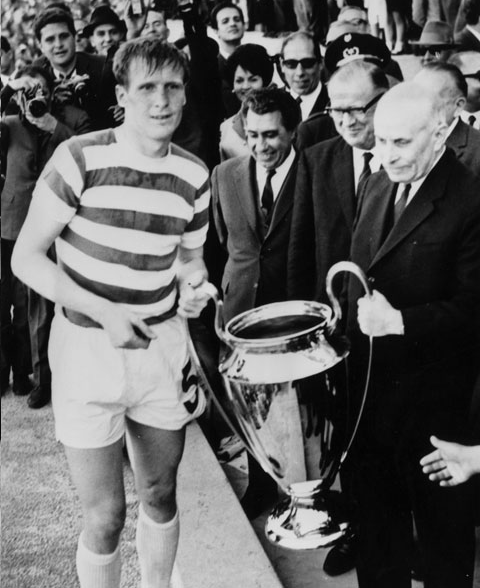
For their skill, bravery and attacking playing style, the Celtic players on the field that day would become known as the ‘Lisbon Lions’, being the first British team to become European champions. Over 50 years later, fans and experts still view Celtic’s triumph as an iconic moment in British sporting history. Today, the 1967 ‘Lisbon Lions’ are considered one of the greatest teams ever to lift the European Cup/Champions League trophy.
Four years later, Jock Stein and much of the side that started in Lisbon would travel to Milan for the 1970 European Cup final. Aiming to finish the 1969-70 season by adding a second European Cup trophy to the league championship and Scottish League Cup won earlier that year, Celtic would need to defeat reigning Dutch Eredivisie champions Feyenoord inside the San Siro on 6th May 1970. However, before describing the final itself, we need to understand how Jock Stein’s men managed to reach their second European Cup Final in four seasons and earn a date with Ernst Happel in the Italian fashion capital.
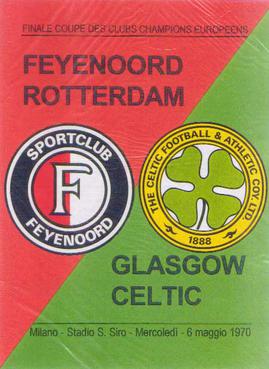
The Build-Up
Following the quadruple-winning season of 1966-67, which would end with the victory in Lisbon, the following two seasons for Celtic would twin continued domestic success with underwhelming performances in the European Cup. While the 1967-68 season would see the Bhoys retain their league championship and League Cup titles, the defending European champions would suffer a shocking first-round defeat to Soviet champions Dynamo Kyiv by a 3-2 aggregate score-line. The team would win a domestic treble a season later, only to lose a close European Cup quarter-final with AC Milan by a single Pierino Prati goal (0-1). Now with the club beginning their fourth consecutive season in European football’s top competition, Jock Stein would hope to make Celtic a threat once more by bringing a second European Cup back to the green-and-white part of Glasgow.
1st Round: vs FC Basel, 17th September-1st October 1969
Celtic would begin their European Cup journey with a first-round tie against the Swiss champions FC Basel. The first leg would see Jock Stein’s team travel to St-Jakob Park on 17th September 1969. However, the Bhoys would later travel the 1,531km back to Glasgow with no clearer idea of their immediate future in the tournament. On a Wednesday evening, 37,857 spectators who had travelled to watch the Swiss champions take on their Scottish equivalent would instead watch Celtic and Basel play out a goalless draw. However, both teams would have their chances to score with little success. Celtic would frequently require the services of goalkeeper John Fallon to keep out several Basel shots. At the same time, the likes of Jimmy Johnstone and Willie Wallace would fail to take their chances to give the Bhoys an away goal to take into the return leg at Celtic Park. The main solace for Celtic would be that they had not conceded during this first leg, meaning that everything was still all to play for in the home leg two weeks later.
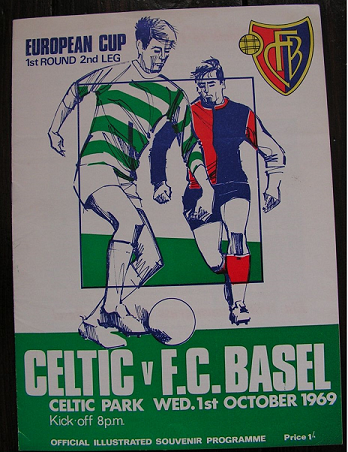
After failing to score in the first 90 minutes against Basel, Celtic would take less than one of the second leg at Parkhead to register the tie’s first goal. Midfielder Jimmy Johnstone would weave through the Basel players before attempting a shot that the defence would block. Retrieving the ball, Johnstone would pass to Hood, who would slam the ball home from close range. After taking this early lead, Celtic would dominate the rest of the first half, and Basel goalkeeper Marcel Kunz would stop several attempted shots from hitting the back of the net. Inexplicably, Celtic would head into half-time, still only leading 1-0. However, Helmut Hauser’s effort on the stroke of half-time would manage to force a save out of home goalkeeper John Fallon, showing that despite Celtic’s superiority, Basel still posed a danger to the Scottish champions.
The second half would see Celtic continue their dominance, with the Basel defence having to stay alert and prevent the score-line from further heading in the Bhoys’ favour. However, in the 70th minute, left-back Tommy Gemmell would pick up the ball 25 yards from goal and fire a shot that would sail over the backwards dive of Marcel Kunz into the Basel net. With that goal, Celtic would win the match and the tie to progress to the European Cup second round, where they would take on a much more troublesome opponent.
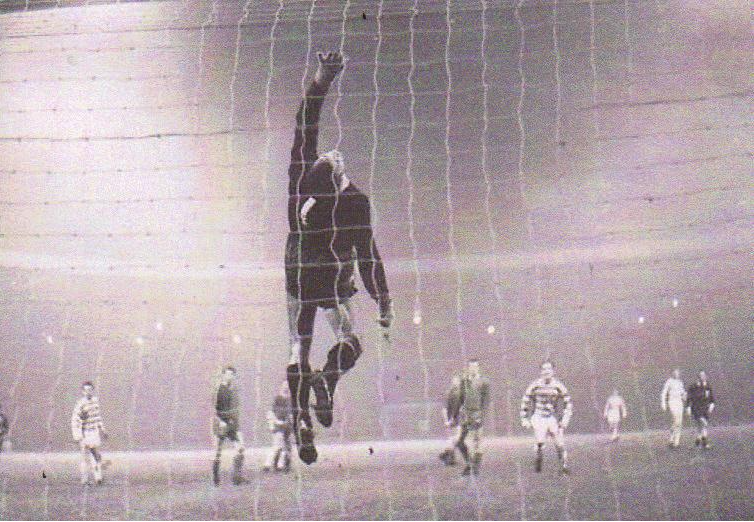
2nd Round: vs Benfica, 12th-26th November 1969
That troublesome opponent was Benfica. The reigning Portuguese champions and two-time European Cup winners (1961 and 1962) defeated the Danish side Kjøbenhavns Boldklub 5-2 (2-0, 2-3) at the previous stage to set up a clash with Jock Stein’s men. For Celtic, facing Benfica would mean coming face-to-face with Eusébio, the 1965 Ballon D’or winner, 1966 World Cup Golden Boot winner and three-time European Cup top scorer (1965, 1966, 1968). The ‘Black Pearl was responsible for scoring four of Benfica’s five goals against Kjøbenhavns Boldklub. The Portuguese international striker would hope to add to his tally of 46 goals in 50 European Cup appearances when he took on Celtic across two legs in November 1969.
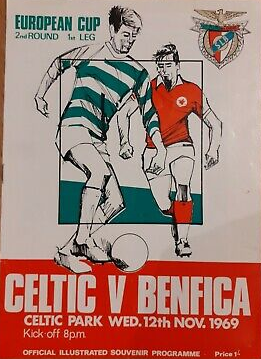
However, any fear or hesitancy that the Celtic players had prior to facing Benfica would soon fade away when the Bhoys took a 2-0 lead inside the first 15 minutes. Left-back Tommy Gemmell would score for the second match in a row, delivering another long-range stunner to beat goalkeeper Henrique from 30 yards inside two minutes. In the 14th minute, Willie Wallace would curl the ball home from a tight angle to double Celtic’s advantage. Benfica was stunned, and the home crowd at Celtic Park were lapping up everything that their team was doing with rapturous delight. Midway through the half, Wallace’s strike partner John Hughes would put the ball in the net for a third time, only for the referee to disallow the goal for a Celtic foul in the build-up.
After these efforts, Benfica keeper Henrique would try his best to limit the damage to just two goals. When Benfica did try to respond, Bhoys goalkeeper John Fallon would spring into action to keep his side’s clean sheet intact. Celtic’s centre-back pairing Billy McNeill and John Clark would make life hard for the prolific Eusebio, and the ‘Black Pearl’ would struggle to influence himself on the match, resulting in a half-time substitution. In the 70th minute, Bobby Murdoch would cross the ball into the Benfica penalty area, and Harry Hood would head home for his second goal in two European matches to put Celtic 3-0. Hood’s header would cap off an excellent performance from Jock Stein’s side, giving the Scottish champions a three-goal buffer to defend going into the second leg in Lisbon.
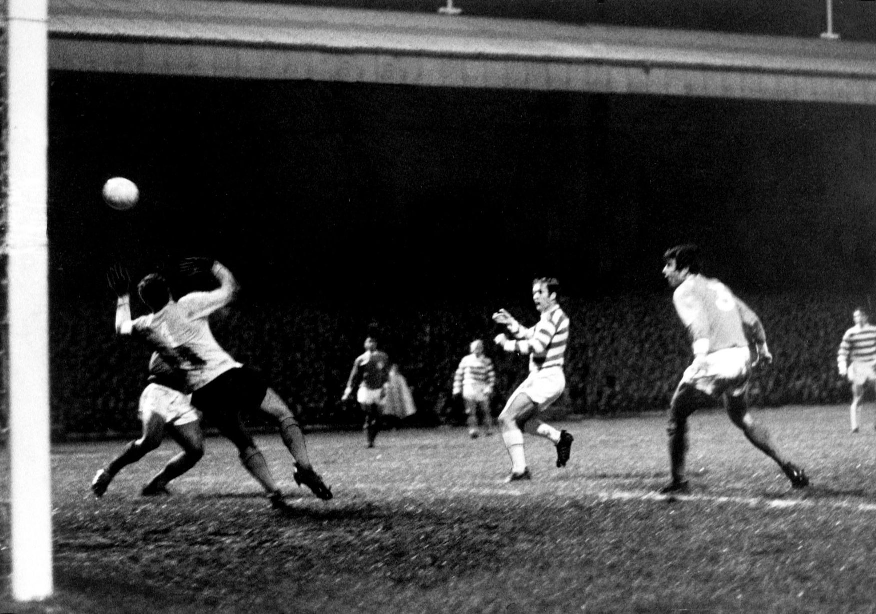
The second leg would see Jock Stein’s Celtic side return to Lisbon, the city where they had become European champions in 1967. However, instead of the reverse fixture between Celtic and Benfica taking place at the Estádio Nacional (the venue for that final), the Estádio da Luz would host the second leg between the two sides. Played in torrential rain, the team known as O Glorioso (The Glorious One) would exact revenge on Celtic for the first-leg defeat. From the beginning, Benfica would hammer John Fallon’s goal with a series of shots that the man from Cambuslang would successfully manage to keep at bay, thus maintaining the 0-0 score-line. However, Fallon’s resistance would finally break in the 35th minute when Eusébio directed a header past him into the net. Five minutes later, midfielder Jaime Graça would double Benfica’s lead, playing a one-two before a sliding a shot in off the left-hand post. The Eagles would carry this 2-0 lead into half-time, and Celtic would need to regroup to keep the fate of this tie in their own hands.
In the second period, Jock Stein’s team would start to show more attacking threat, with Jimmy Johnstone coming closest to pulling a goal back soon after half-time. However, the Bhoys could not add to the three goals they had scored back in Glasgow and would nervily cling onto their one-goal aggregate advantage as the minutes ticked down. In the third minute of injury time, Benfica would earn a corner kick. As the ball crossed into the Celtic penalty area, Dutch referee Laurens van Ravens would blow the whistle to end the match. As the Celtic players switched off, substitute Diamantino Costa would head the ball home for Benfica’s equaliser, levelling the aggregate score at 3-3. As Diamantino celebrated with his teammates and Benfica fans joyously flooded onto the field, the Celtic players would complain to van Ravens, claiming that he had blown for full-time before Diamantino’s goal. However, despite Celtic’s protests, the goal would stand, and the match would end in a tie.
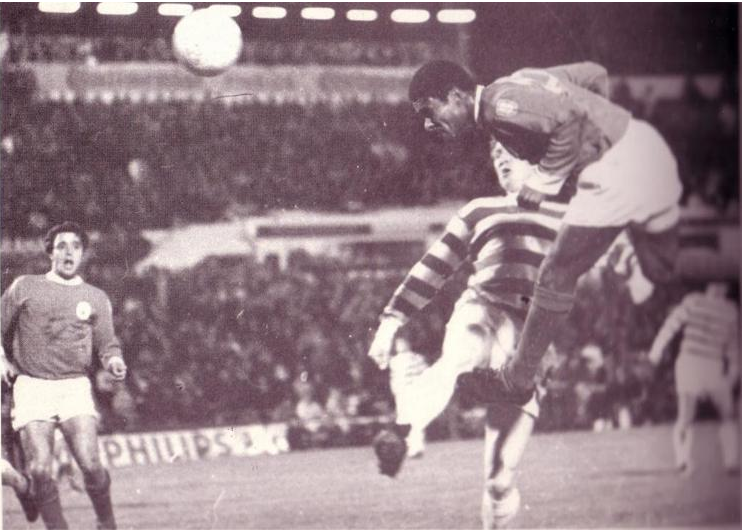
If Diamantino’s last-minute equalising goal had been controversial, then the method to decide the winner of the tie between Celtic and Benfica would only cause more controversy. As per the competition rules, in the event of a tied aggregate score after two legs, a coin toss would decide the winner of the round. Laurens van Ravens would bring captains Billy McNeill and Mario Coluna plus managers Jock Stein and Otto Glória into the referee’s dressing room at the end of the second leg. The referee would toss a coin into the air. McNeill would correctly call ‘heads’ and would earn the right to flip the official coin himself. After another coin toss, McNeill would again successfully call ‘heads’ and Celtic were into the third round of the European Cup just like that.
Celtic chairman Sir Robert Kelly would complain to UEFA in the days after the match about the method of coin tosses settling European ties, and he would get his wish. After 1970, the now-familiar method of extra time and penalty kicks would decide a tied two-legged European Cup match.
Quarter-final: vs Fiorentina, 4th-18th March 1970
After the controversial ‘win’ over Benfica, Celtic would face Fiorentina in the European Cup quarter-finals. In their first European Cup campaign in 13 years, Fiorentina had defeated Swedish champions Östers IF in round one (3-1 agg), before edging Dynamo Kyiv 2-1 in round two to reach the last eight. Captained by Giancarlo De Sisti, La Viola would hope to defeat Celtic and continue their quest for a second European Cup final appearance, following a losing effort to the all-conquering Real Madrid back in 1957.
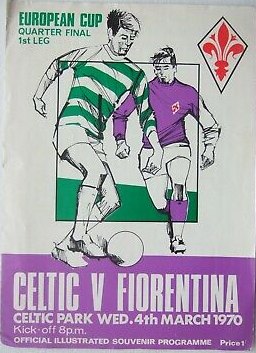
For the second time in the competition, Celtic would win the first leg of a European Cup tie 3-0. Fiorentina goalkeeper Francesco Superchi would have his work cut out to stop the barrage of shots that Jock Stein’s team would level at his goal across the 90 minutes. The first goal would come after 30 minutes, as midfielder Bertie Auld would fire a shot past the dive of Superchi into the Fiorentina net. Then, a man in purple would inadvertently offer assistance to Jock Stein’s side. Bertie Auld would deliver a cross into the opposition penalty area. While trying to clear the ball, Fiorentina defender Francesco Carpenetti would end up lifting the ball past his goalkeeper to make the score read 2-0 to Celtic. Finally, in the 89th minute, Harry Hood would flick on another Auld cross, and Willie Wallace would knock the ball past Superchi for the third goal. For the 77,240 people inside Parkhead that night, the Bhoys had certainly put on a show and would now defend a three-goal advantage in Florence two weeks later.
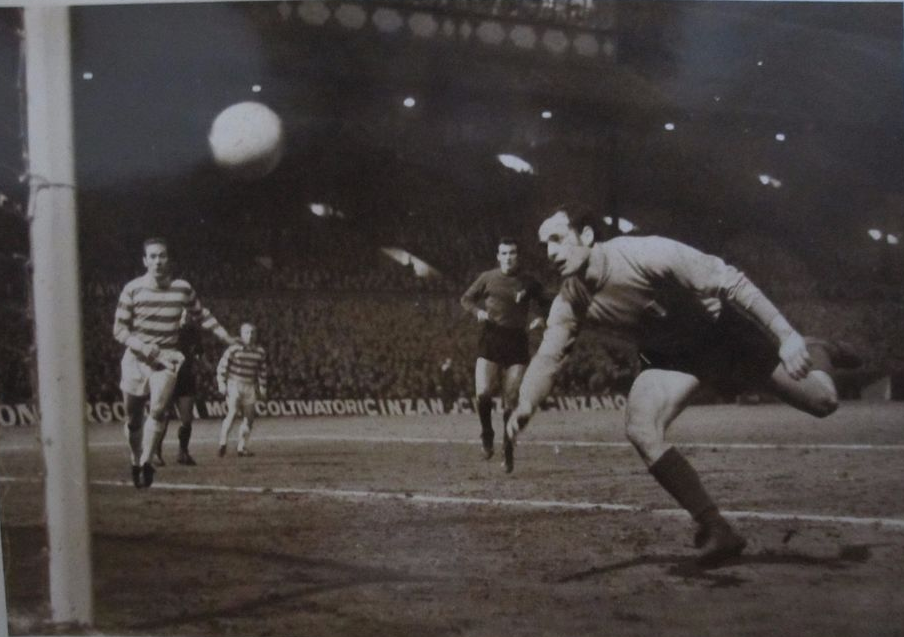
Not wanting a repeat of the second leg against Benfica, Celtic would adopt a more suppressive style in the reverse fixture against Fiorentina on 18th March 1970. The visitors’ defence and midfield would stop the Florence side from creating clear-cut chances for their attacking players, and Celtic keeper Evan Williams would serve as an excellent shot-stopper whenever the Violets threatened a goal. Fiorentina’s best period would come after the half-hour mark when two shots would cross the Celtic goal-line. In the 34th minute, home striker Luciano Chiarugi would directly score from a free-kick, only for referee Rudolf Scheurer to disallow the goal. Then, three minutes later, Chiarugi would hit a low shot past Williams after the Celtic defence had failed to clear their lines.
After Chiarugi’s goal, Celtic would contain Fiorentina within the midfield areas, not allowing La Viola many chances to close the gap on aggregate. For the rest of the match, Celtic would effectively and successfully ‘park the bus’. The game would end in a 1-0 win for Fiorentina, but Celtic would advance to a second European Cup semi-final. Celtic’s opponents in the semi-finals: Don Revie’s Leeds United.
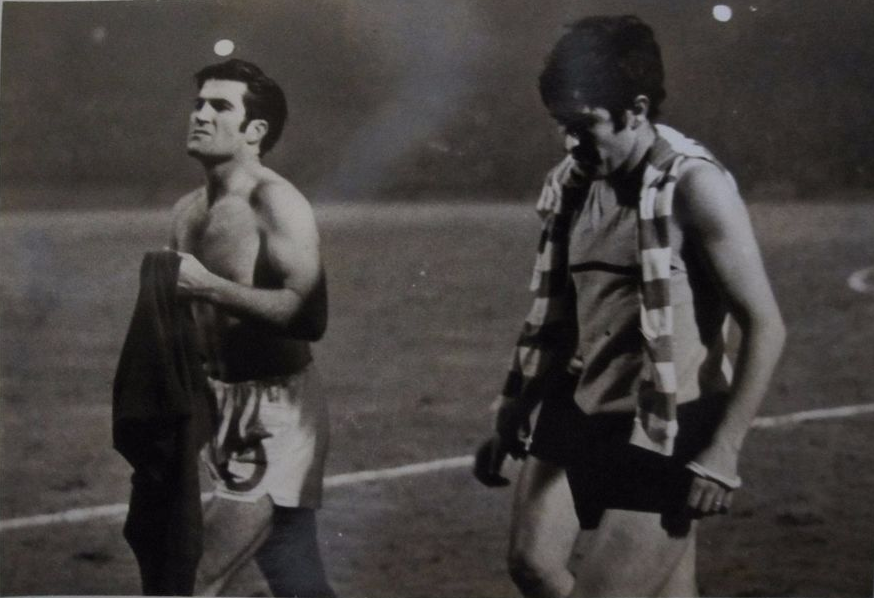
Semi-final: vs Leeds United, 1st-15th April 1970
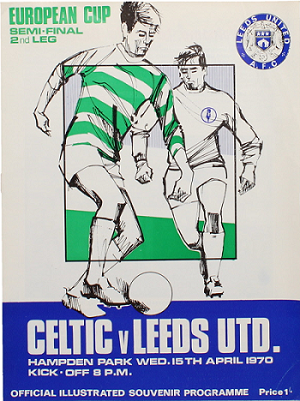
The 1969-70 season would see Leeds United make their UEFA European Cup debut after winning their first English league title the previous year. Before this season, Leeds’s experience of European football had come through four consecutive seasons in the Inter-Cities Fairs Cup (the precursor to the UEFA Cup/Europa League) between 1965 and 1969. The Whites would win the competition in 1968, beating Ferencváros 1-0 in a two-legged final. Now less than two years later, Leeds were set to face former European champions Celtic in a two-legged European Cup semi-final, with the chance to play in the San Siro on 6th May the prize at stake. The Celtic-Leeds semi-final would mark the first all-British tie in the entire history of the European Cup.
To make the final four in 1970, Don Revie’s Leeds team had produced the most impressive performances of any team in the tournament. The Yorkshire team would begin with a 16-0 (10-0, 6-0) aggregate win over Norwegian side Lyn before defeating Ferencváros 6-0 (3-0, 3-0) in a repeat of the 1968 Fairs Cup final. Finally, Leeds would register consecutive 1-0 wins over Standard Liege to advance to the semi-finals. Now, Celtic had to defeat a side that had not conceded one goal in six matches and 540 minutes of European football.
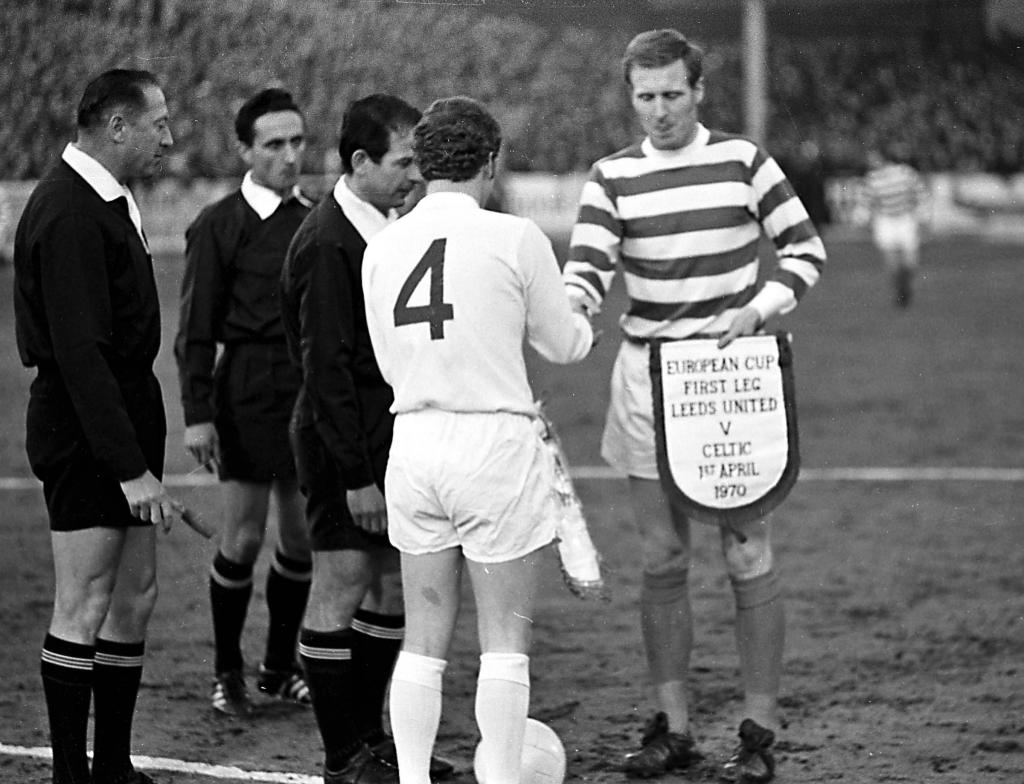
Leeds United went into the first leg of the semi-final with a 100% winning record at Elland Road. However, inside the first minute of the first leg, that record would immediately come under threat. After Leeds failed to clear a bouncing ball, midfielder George Connelly would score with a deflected shot to put the visitors ahead 1-0. The 10,000 Celtic fans among the 46,381 total attendees would roar their approval while the home crowd immediately went silent out of sheer surprise. As well as being the first goal that Leeds had conceded in that season’s European Cup, it was also the first goal Celtic would score away from Celtic Park in the same competition.
Leeds top scorer Mick Jones would have a chance to equalise within minutes, but upon collecting the ball from Paul Reaney’s cross, he would tamely hook the ball wide. At the other end, Jock Stein’s team would harry a make-shift Leeds defence missing the stability of Norman Hunter, and shots from Bobbys Auld and Murdoch would clear the crossbar. Leeds goalkeeper Gary Sprake would also need to save well from Willie Wallace’s header as Celtic searched for a second goal. On the verge of half-time, Leeds winger Peter Lorimer would have two chances to equalise but would waste both of his efforts.
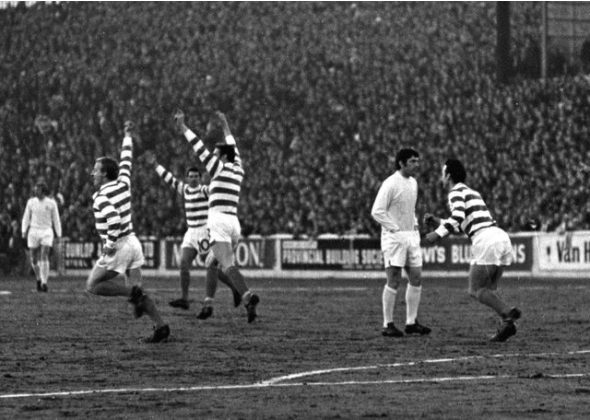
Celtic would maintain their 1-0 advantage until half-time and would almost add to it immediately following the break. In the first minute of the second half, Connelly would fire home from a Jimmy Johnstone cross, only for West German referee Gerhard Schulenburg to disallow the goal and award a free-kick to Leeds United due to Johnstone being offside. In the 70th minute, Mick Jones would pounce upon Jim Brogan’s failed clearance but would subsequently miscue his shot past the post. Allan Clarke would also force Bhoys keeper Evan Williams into his first meaningful save of the evening. Leeds would pose further threats to the Celtic defence during the second half but could not find the equaliser to protect their unbeaten home record. Ultimately, Celtic would leave Elland Road with a 1-0 win, an away goal and the aggregate lead in the semi-final.
Instead of the familiar comforts of Parkhead, Celtic F.C. would choose the larger Hampden Park as the home venue for the European Cup semi-final second leg against Leeds United on 15th April 1970. When 135,805 people (a record attendance for a UEFA club competition) would manage to fill the national stadium, the two clubs knew that the appetite was there for a match between the respective champions of Scotland and England. With Celtic holding a slender 1-0 lead from the first leg, Don Revie and his Leeds team still had a chance of beating the former European champions inside their own country. When Leeds captain Billy Bremner would score the opening goal by firing a 20-yard effort past Evan Williams in the 14th minute of play, both sides knew the tie was now well and truly on. Leeds now had their away goal, and more importantly, had levelled the aggregate score at 1-1.
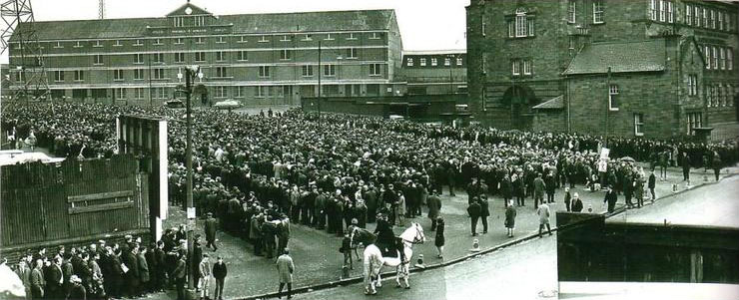
Leeds’s goal had come completely against the run of play as Celtic had begun the match by forcing six corners inside the first eight minutes. Jimmy Johnstone was finding gaps around the field, and the Bhoys provided much of the attacking momentum in the early stages. A Bobby Murdoch shot would even strike the Leeds post with goalkeeper Gary Sprake beaten. Now that Leeds had taken the lead and levelled the aggregate, Celtic would need to convert their early dominance into goals. Leeds defenders Terry Cooper and Paul Madeley would twice clear the ball off their own goal-line, and Sprake would save a John Hughes shot. However, despite Celtic’s attacking efforts, Leeds would manage to hold their 1-0 lead at half-time.
Two minutes after the break, Celtic’s pressure would finally tell. Bertie Auld would cross the ball into the Leeds box, and John Hughes would glance a header past Gary Sprake. Two minutes later, a challenge with Hughes would force Sprake off with a knee injury. On the Leeds treatment table, Sprake would join Mick Jones, who had Bertie Auld to thank for forming a gash in his right shin. However, things would get even worse for Leeds soon enough. In the 51st minute, Bobby Murdoch would play a one-two with Jimmy Johnstone before smashing the ball past substitute goalkeeper David Harvey. Therefore, for all Leeds United’s first-half efforts to get back on level terms, two goals in four second-half minutes had put Celtic 2-1 ahead on the night and 3-1 up on aggregate.
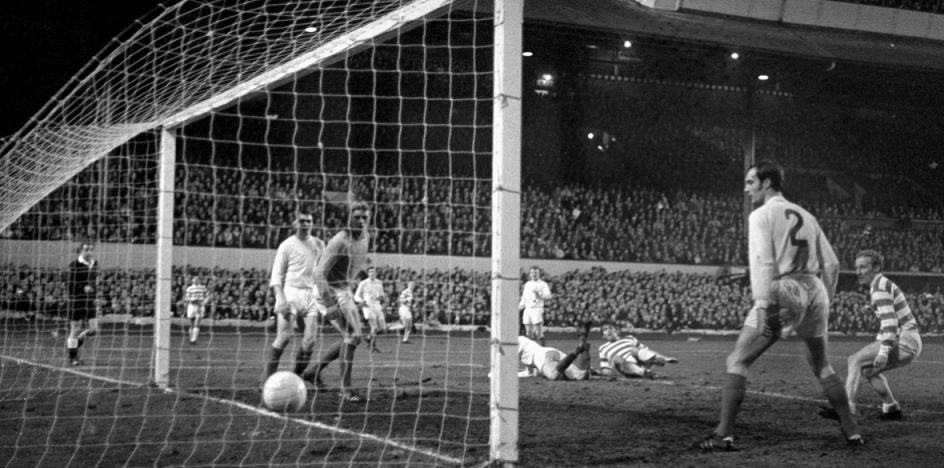
Now, it was Leeds’s turn to attack on all fronts, with even Jack Charlton getting forward on many occasions. Don Revie would even send regular centre-back Billy Bremner up top as a rudimentary striker. However, nothing Leeds could do would affect Celtic. In the dying minutes of the match, it was Celtic who would come close to scoring once more, only for Paul Madeley’s block to stop John Hughes from scoring his second goal of the match. After that clearance, referee Michel Kitabdjian would blow his whistle, declaring Celtic as the winners. In the game termed ‘The Battle of Britain’, the Scottish side had won the day, and now Celtic could look ahead to a second European Cup final in four years. On 6th May 1970, Jock Stein’s team would attempt to become the ‘Milanese Lions’. To earn that nickname, Celtic would need to defeat reigning Dutch champions Feyenoord at the San Siro.
Final: vs Feyenoord, 6th May 1970
In 1967, Celtic had entered the European Cup final against Inter Milan as the underdogs. Internazionale went into that final as former two-time European champions, and the Bhoys were coming to the end of their first season in the European Cup. In 1970, Celtic would enter the final as overwhelming favourites to defeat their opponents Feyenoord. This time, Celtic were the former champions looking to add to their tally, while Feyenoord lacked major final experience. The 1969-70 season had seen the Rotterdam side return to the European Cup for the first time since a preliminary round exit in 1966, with the club’s best performance, a semi-final defeat to Benfica, occurring way back in 1963.
While Celtic was making their second appearance in the European Cup final, Feyenoord was making their debut. Ernst’s Happel’s team would begin their European Cup campaign with a heavy 16-2 (12-2, 4-0) defeat of Icelandic champions KR. In the second round, Feyenoord would lose the first leg against AC Milan 1-0 before winning the return leg 2-0. The same thing would happen in the quarter-finals, with Vorwärts Berlin winning 1-0 in East Germany, before De Stadionclub turned the tie on its head with a 2-0 win in Rotterdam. The team’s home form would also help them out in their semi-final clash with Legia Warsaw, as another 2-0 victory would effectively win them their place in the final following a goalless first leg. Judging on that form, you can see why Celtic were the favourites heading into the final on 6th May. To win, Jock Stein’s men could call upon the memories of Lisbon four years earlier to strive them forwards, while Ernst Happel’s Feyenoord would need to show off the resiliency and never-say-die attitude that had got them to the biggest match in their history.
Here is how the teams lined up on the night:
| Feyenoord | Celtic | |||
|---|---|---|---|---|
| (4-3-3) | Formation | (4-2-4) | ||
| Eddy Pieters Graafland | GK 1 | GK 1 | Evan Williams | |
| Piet Romeijn | RB 2 | RB 2 | David Hay | |
| Theo Laseroms | CB 4 | CB 5 | Billy McNeill (c) | |
| Rinus Israël (c) | CB 3 | CB 6 | Jim Brogan | |
| Theo van Duivenbode | LB 5 | LB 3 | Tommy Gemmell | |
| Franz Hasil | RM 6 | CM 4 | Bobby Murdoch | |
| Wim Jansen | CM 7 | CM 10 | Bertie Auld | |
| Willem van Hanegem | LM 10 | RW 7 | Jimmy Johnstone | |
| Henk Wery | RW 8 | CF 9 | John Hughes | |
| Ove Kindvall | CF 9 | CF 8 | Willie Wallace | |
| Coen Moulijn | LW 11 | LW 11 | Bobby Lennox | |
| Ernst Happel | Manager | Jock Stein |
Feyenoord would register the first meaningful chance of the 1970 final when striker Ove Kindvall would play a one-two with midfielder Willem van Hanegem before releasing a shot from a tight angle that Evan Williams would quickly turn past the post. Later, excellent passing around the Celtic box would end with midfielder Franz Hasil firing a shot across the face of goal and wide. Feyenoord would enjoy the best of the early possession, and another Hasil shot would send Williams diving to his right to stop the rising effort. However, in the 30th minute, Celtic would earn a free kick on the edge of the Feyenoord penalty area. As he had done against Benfica in the second round, Bertie Auld would flick the ball back to Tommy Gemmell, who would fire a 20-yard effort through the defensive wall and into the net. After withstanding early pressure from their opponents, Celtic had scored the first goal of the 1970 European Cup final.
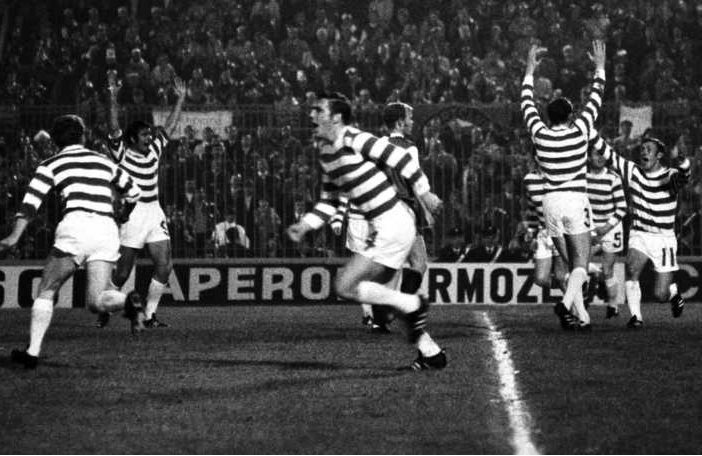
However, Feyenoord would earn a free kick of their own two minutes later. Franz Hasil’s lifted ball would cause chaos in the Celtic box, and captain Rinus Israël would nod home an equaliser from seven yards. Celtic’s lead had lasted less than two minutes. However, before the end of the first half, Tommy Gemmell would almost score a second goal when his in-swinging cross would leave Feyenoord keeper Eddy Pieters Graafland flapping to turn the ball wide. At half-time, the score stood at 1-1.
In the second half, Feyenoord would almost score their second goal. A combination between Ove Kindvall and Henk Wery would result in a Franz Hasil shot bouncing off the left-hand post. At the other end, another Gemmell cross would once again force Pieters Graafland to tip the ball over his crossbar. Feyenoord would enjoy the more clear-cut chances in the second half, while Celtic resorted to hopeful shots from a distance. Ernst Happel’s side was effortlessly finding gaps in the usually tight and resolute Celtic midfield. A neat passing triangle from van Hanegem, Wery and Wim Jansen would end with the former delivering an outside pass to left-back Theo van Duivenbode. The defender’s shot would leave Evan Williams scrambling across his goal as the ball missed the far post by mere inches.
Later on, Wim Jansen would thread a beautiful ball towards winger Henk Wery, who would only end up skewing his shot wide while attempting a deft finish across the goal. However, when referee Concetto Lo Bello would blow his whistle for full time, the score would still read 1-1. Therefore, extra time would ultimate decide the 1970 European Cup final.
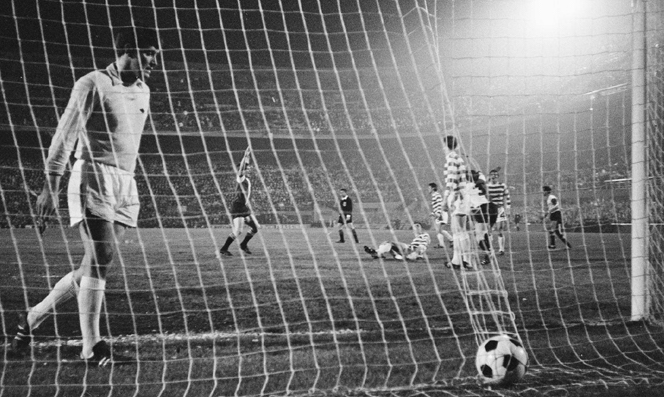
Straight from the kick-off, Celtic player John Hughes would intercept Feyenoord’s possession and bear down on the opposition goal. However, Hughes’ shot would only find the legs of Eddy Pieters Graafland. From that save, a misplaced touch from Rinus Israël would almost result in an embarrassing own goal, with Pieters Graafland scrambling back to claim the ball before it could cross the goal-line. Down the other end, the ever-impressive Franz Hasil would come close yet again, firing another shot just wide of the Celtic net. Thus, at the end of the first fifteen minutes, both sides were still trying to find the crucial goal to win them the European Cup.
In the second half, Feyenoord would treat the spectators inside the San Siro to a spectacular counter-attack. Substitute Guus Haak would head away a Celtic cross, and another header from the midfielder would start the counter-attack. Playing a one-two with Henk Wery, Haak would run deep into the Celtic half before passing the ball forward to Ove Kindvall. Kindvall would turn inside one Celtic defender before poking a shot towards the goal that Evan Williams would stop with his feet. Then, the ball would roll out to Wery, who would force another great save out of the Scottish goalkeeper. The Celtic players would breathe a brief sigh of relief, but the Dutch champions would continue their assault on the Bhoys’ net. Minutes later, great passing from van Hanegem and Hansil would set up Kindvall for a shot that whipped across the face of the goal. At this moment, it now seemed like there would only be one winner.
In the 117th minute of play, the goal would finally arrive. Feyenoord would receive a free kick inside the centre circle, which Israël would take quickly, knocking the ball into the Celtic box. A retreating Billy McNeill would lose his balance just inside the penalty area, handling the ball twice as he fell backwards. Finally, the ball would fall to Ove Kindvall on the run, and the Swedish striker would lift the ball over the advancing Evan Williams into the Celtic net. The rest of Kindvall’s teammates would rush over to celebrate with him, lifting the Swede onto their shoulders. However, if you thought the match was now over, nobody told Feyenoord. One minute after their goal, a counter-attack from a Celtic free-kick would see Kindvall hold the ball on the edge of the Celtic area before feeding Franz Hasil. However, once again, Hasil’s shot would hit the woodwork, bouncing off the crossbar just the wrong side of the goal-line. It was a signal of Feyenoord’s dominance throughout the match, and two minutes later, the final whistle would confirm Ernst Happel’s side as European champions.
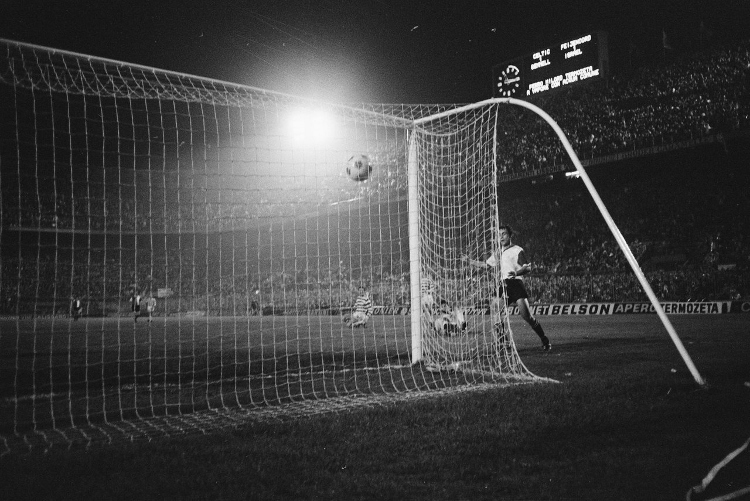
Feyenoord were now the champions of Europe, becoming the first Dutch side to win the European Cup, starting four consecutive victories in the competition for teams from the Netherlands. Despite their underdog tag heading into the match, Feyenoord had dominated the final from start to finish and really should have won the game within 90 minutes.
Aside from the goal that saw Tommy Gemmell join the ranks of players to score in two European Cup/Champions League finals, Celtic was poor throughout the night despite entering the match as overwhelming favourites. Unfortunately, the ‘Lisbon Lions’ of 1967 had not become the ‘Milanese Lions’ of 1970. The Celtic players looked shell-shocked at the final whistle, not knowing what had just hit them. Perhaps, Celtic had underestimated the quality of Feyenoord heading into the match and therefore paid for their complacency when the final arrived. Jimmy Johnstone would confirm this point of view in later years. Captain Billy McNeill would later say that the defeat “took a lot out of the club…we never quite got back to that level again.”
After the defeat in Milan, Celtic would continue to dominate the Scottish league under Jock Stein, winning the following four championship titles to complete a remarkable nine-in-a-row. However, the club would manage two quarter-final and two semi-final appearances in the European Cup during this time. After one more league title in 1977, Jock Stein would leave Celtic the following year, with Billy McNeill replacing him in the job. McNeill would spend five years at Parkhead, winning three league titles and five trophies in total before leaving in 1983. He would later return for another four years between 1987 and 1991. During his time in charge, Celtic would make it beyond the second round once, losing to Real Madrid in the 1980 semi-finals. Celtic would not even get that far again over the following forty years.
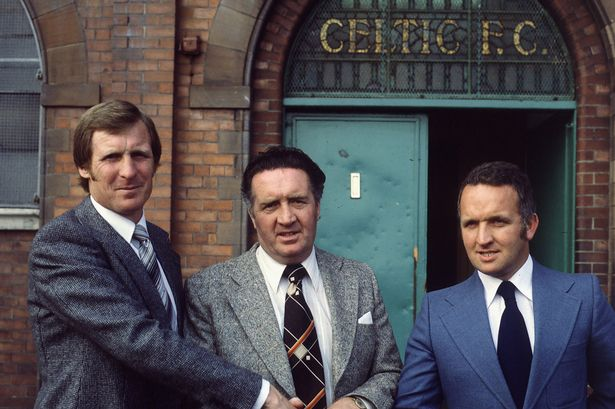
No one would know it at the time, but the 1970 European Cup final would signal the end of the ‘Lisbon Lions’ as a major European force. Never again would the Bhoys reach those unrivalled heights. After famously triumphing in the role of the underdog in 1967, Celtic would struggle with the favourites tag in 1970, and Feyenoord would dutifully capitalise. Aside from a quarter-final defeat to Benfica in 1972, Feyenoord themselves would never again replicate the events of 1970. However, they will always have that one European Cup win to reminisce about. Therefore, while Celtic fans will always have Lisbon 1967 to look back upon, Feyenoord fans will always have Milan 1970.



